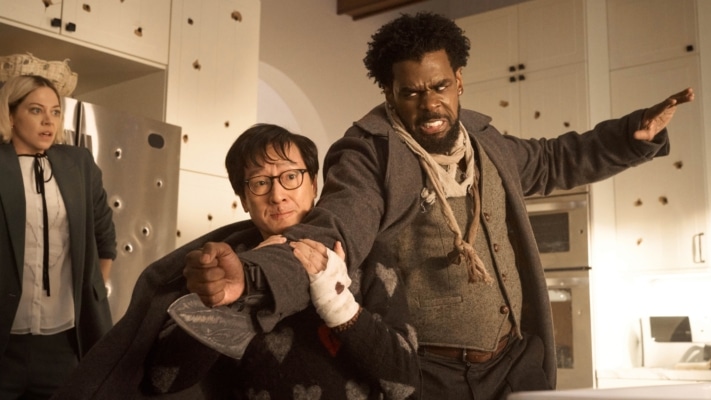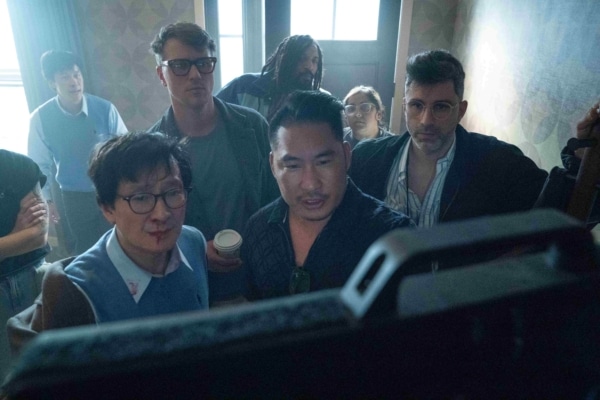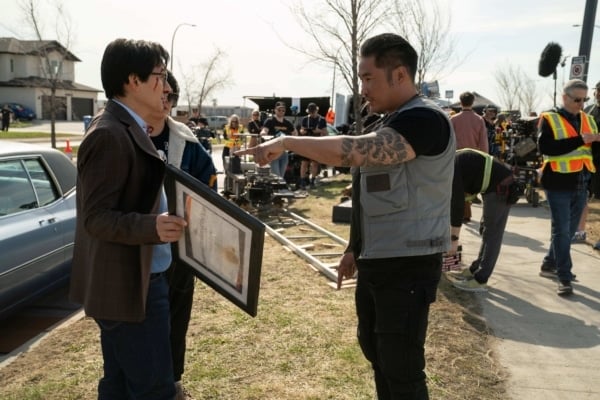Ke Huy Quan has been riding high since returning to the acting world with Everything Everywhere All At Once. The Academy Award-winning has been popping up in other projects here and there, and it was only a matter of time before he starred in a leading man role. Stunt coordinator and performer Jonathan Eusebio finally heard the call to direct his first feature film, and that’s when the stars began to align. The script for Love Hurts, known initially as With Love, wound up in both men’s hands, and everything clicked.
Eusebio and Quan saw something special in the script written by Luke Passmore, Josh Stoddard, and Matthew Murray that would be a grand entry in the action rom-com genre. The filmmaker and actor felt they could bring something new from 87North Productions that thrilled their audience and could be a great date movie. Eusebio had options to try what he called a “standard fare” action film but loved the premise of Love Hurts, which allowed him “different aspects” to try out.
Fortunately for us, the director, with the aid of Quan, co-star Ariana Debose, and his stunt crew, showcased a fun film and reminded us that Quan’s acting resurgence is still in full swing. We got to talk to Eusebio about the early stages of the production of Love Hurts, collaborating with his lead actors, and what influenced his storytelling abilities.
You discussed what it took to get you into the director’s chair. What about this script for Love Hurts that gave you the idea of “I want to direct this movie. I want this to be my first feature?”
Jonathan Eusebio: I wanted to do something that kind of set me apart from my peers. I was getting a lot of scripts and kind of the standard fare, like “Hitman escaping whatever situation he’s in,” kind of military teams trying to get out of something or save people or hostages or things like that. But when I read the script, I loved the premise, and it allowed me to do different aspects. I can do comedy, I can do action, I could do a little bit of romance. So, I think it allowed me to spread my wings a little bit, and that’s why I did it.
Is there anything within the script that popped out that informed your vision or how you want to approach this story?
Jonathan Eusebio: I read the premise, and I liked the premise. I like it when you have an unassuming everyday man, and then you don’t expect when he does this twist. He comes out of nowhere. I love those kinds of movies. After Ke wanted to become involved, I knew I’d go, “Okay, now I can structure this action off how he moves or what he likes. I grew up watching a lot of 80s Hong Kong action movies. So, many of my influences and sensibility of action are from those movies. This was like my love letter to those movies, but I also needed a cast that could do the action I wanted them to do.
Yeah, I noticed that in the movie, one particular part is the scene where the villain’s lair is. It is a very homage to Kung Fu cinema and people’s obsession of that time in that era. It reminded me of a lot of video stories from when I grew up.
Jonathan Eusebio: Glad you got that.
You said in a previous interview why you changed the title from With Love to Love Hurts. Were there other titles you guys were kicking around that might’ve been a better fit?
Jonathan Eusebio: No, I mean the original one was basically just Gable, his last name, but it doesn’t really show what the movie’s about. So With Love was a great title, too, but I think Love Hurts fits the movie more because love is a multifaceted emotion. It can mean many things to different people; it could be the greatest feeling. It can be the worst. There are different types of love. So, I think that title fits the movie more.
You’re working with Ke; he’s worked in stunt choreography in the past, and you’ve also done that in your experience. Did you two combine your experiences to make a more collaborative effort?
Jonathan Eusebio: Yes, of course. I think for me as a first-time director, I came up from the background of a performer, which kind of weighed in my way up to running departments and stuff. I’m used to that level of collaboration, so I like it. I think that the best stuff comes out of it. The fact that we spoke the same language when it came to action just made the process easier. We didn’t have a lot of time to shoot—we had a short shoot schedule. There’s a shorthand that he knows that I know, and my stunt team knows more, which helped us accomplish what we set out to do.
Speaking of collaboration, you’re working with Ariana Debose; she has a dance performance history. Did you guys utilize that to build her fight style in Love Hurts?
Jonathan Eusebio: Yes, because I mean fight choreography in film and dance choreography are very similar in the way it’s performed or the process of doing it. So, I had no doubt that she was going to pick things up because she’s such a talented physical performer. Knowing these things, I got very lucky because I feel like my whole cast was very physically adept, and in order to do the kind of action and stay in the long takes that we do, you need a performer to be able to do that. I mean, I was fortunate. I got performers that are emotionally built for that performance, but also on the physical side of it. I got very, very lucky.
Yeah, you got the perfect team together. They work so well and are in sync for this type of movie.
Jonathan Eusebio: Yeah. Again, I talk about time constraints. We were shooting fast; we had a short shoot schedule. It was good to have performers who were just kind of ready to go and had the open mind to sort of say, “Okay, let’s just go this door, wing it, let’s go this way.” It makes it more organic and gives it a visceral, gritty feel.

Well, you’re talking about the production. Was there anything you wanted to shoot or put together but couldn’t do for some reason?
Jonathan Eusebio: Well, I mean, again, a lot of stuff is just based on time constraints. If you leave me to it, I’ll shoot 20 minute fight scene. Of course, I want to do more and more, but at the same time, I have to finish within the time constraints I have and do the best with what I have. I think we really, really did the best we could. There’s a lot of multiple factors going on, but we got lucky. Sometimes you get lucky, and sometimes you have great performers. All these factors just happened at the same time when we were able to pull off what we needed to do.
So, since this is your first feature film and stunt performers becoming directors, it was nothing new. Buster Keaton set the whole thing in motion, and there’s David [Leitch], Chad [Stahelski], J.J [Perry], and yourself making Love Hurts and these films. It seems like there’s this wave of stunt performers becoming directors. Do you see that wave growing with these types of action films that are becoming more in demand?
Jonathan Eusebio: No, I think there’s a push, obviously, for stunt people to get Oscar. In the past, I think stunts were always just associated with servicing what was on the page. But I would say a lot of the stunt coordinators and sequence directors are great filmmakers as well, and they contribute a lot to the overall film, and it’s just nice for them to get recognized. So, the more people come out to watch films that are helmed by stunt performers or directors, the more I think it will cause an influx of more.
Since Love Hurts is your first action film, is there another genre you want to tackle?
Jonathan Eusebio: I mean, eventually, yes, you want to grow as a storyteller, but I think action is my bag, and that’s my thing. I think for me, it’s just applying what I learned in this movie and doing another that’s something else, and there’s no specific genre. I think it’s always what you read and can relate to, and you can put your sensibility into that story you want to tell because if it evokes a certain feeling in me, I have to take that and invoke that feeling to the audience.
So, is there another project you have next, or maybe a passion project?
Jonathan Eusebio: Well, I’m enjoying this moment here, but I have a couple of things that I’m reading or having meetings for, so there’s nothing specific yet. Again, it’s really about finding the one thing I go for, which gives me the same feeling as this script did when I read it.
Now you’ve worked with Marvel, you’ve worked with DC, and you’re a director. Of course, they’re always looking for directors. Is there maybe a superhero that you think, “I can probably Make a movie out of this one.”
Jonathan Eusebio: I grew up reading comics, so I love all the characters. I grew up on anime, and I grew up on Star Wars and all these things. I think it’s just a matter of finding the right script that resonates with you. I don’t really have a specific thing. I’m not like, “I have to do this, I have to do this.” I was a big fan of all those genres growing up. It’s a part of me anyway. So I think it’s just that if I see something that resonates, I’ll chase it.
You said anime, and whenever someone talks about anime, my ears perk up. Really?
Jonathan Eusebio: Well, I grew up on the old kind of robot mecha. I grew up on Macross and Akira.
Yeah. I am of that era, especially the turn of the ’90s era of anime, where we got Ninja Scroll, Ghost in the Shell, and Patlabor.
Jonathan Eusebio: That stuff, that’s the point I credit I grew up on.

Is there a particular anime that you love to do?
Jonathan Eusebio: I mean, long-form storytelling. So, remember it was made into Robotech?
Yeah.
Jonathan Eusebio: I used to make sure I got home afternoon at 3:30 or four o’clock to watch it. And so I remember getting so psyched about it. Then I remember seeing Akira in Little Tokyo, at a theater somewhere, and I was so entranced.
You were blown away by that.
Jonathan Eusebio: Yeah, so those feelings of sense of “awe” when I watched those movies—I just try to invoke that or make the audience feel that?
You take what anime made you feel and try injecting it into your storytelling.
Jonathan Eusebio: Well, that’s your sensibility. Your sensibilities are to shape the stuff you grew up reading, watching, and experiencing.

